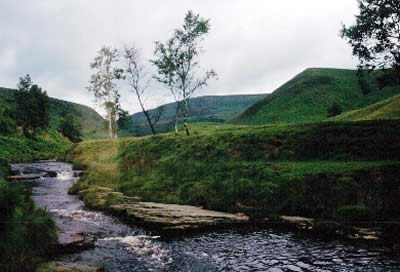Hydroinformatics and Management Systems
MSc, Diploma, Certificate and Professional Development Courses for Water Industry Professionals
A Brief Tour of the Derwent

The Upper Catchment
|

The River Ashop
Inlet from the River Ashop into Derwent Reservoir
Construction of river intakes from the Rivers Ashop and Alport, so providing gravity transfer into Derwent Reservoir, increased the usable area of the catchemnt for the reservoirs in the upper Derwent Catchment. While other resources have largely replaced this part of the scheme, it remains important in the overall control of water resources in the Derwent Catchment.
[ Back to top of page ]
|

The River Derwent
The River Derwent at Slippery Stones above Howden Reservoir
Characteristics of the catchment upland zone are high precipitation and low demand for evapotranspiration. This leads to high export of water and sediment to the lower reaches of the catchment. Water quality at this point is soft (note the brown peaty colour to the water). Land use is predominately marginal agriculture with forestry.
[ Back to top of page ]
|
Reservoirs in the Upper Derwent
|

Howden Reservoir
The highest and oldest (formally opened in 1912) of the three 'Derwent' Reservoirs
This is a naturally filling reservoir, with water flowing by gravity either for treatment at the Bamford Water Treatment Works and then via the Derwent Valley Aqueduct to the Midlands or supplied to Yorkshire Water via the Rivelin Tunnel.
[ Back to top of page ]
|

Derwent Reservoir
The second of the two reservoirs constructed by the Derwent Valley Water Board
Built between 1902 and 1916, the dam is of a masonry construction. Originally solely operating in conjunction with Howden Reservoir, increasing demand led to the construction of an intake from the River Ashop. Later still, Ladybower Reservoir augmented the storage of the Derwent Valley reservoirs.
[ Back to top of page ]
|

Ladybower Reservoir
Ashopton Viaduct crossing Ladybower Reservoir
The flooded village of Ashopton is approximately 30 metres below the top water level. While it increased the usable catchment, ensuring security of supply, water from Ladybower needs pumping from the reservoir to the water treatment works and the Rivelin Tunnel, giving it the the most expensive running costs of the three upper reservoirs.
[ Back to top of page ]
|

The Derwent Valley Aqueduct
The Derwent Valley Aqueduct crossing Ladybower Reservoir
At this point the aqueduct is carrying raw water to Bamford Water Treatment Works. Downsteam of Bamford the aqueduct becomes potable and with augmented flow from various Derwent Valley water treatment works. The additional water also helps in balancing the soft and relatively acidic nature of the water from the upper Derwent Catchment.
[ Back to top of page ]
|
|
|

